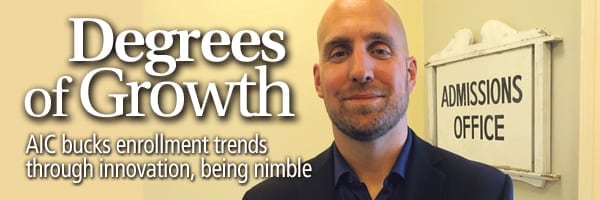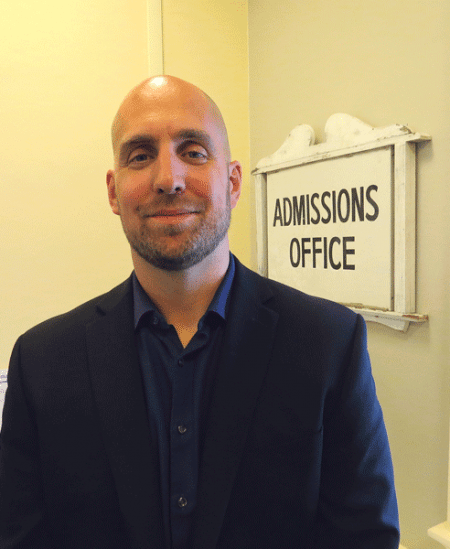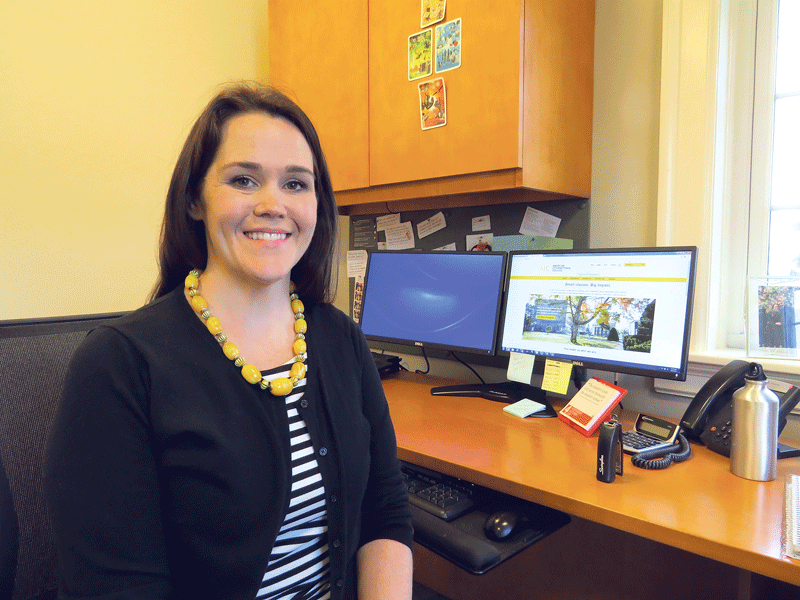
AIC Bucks Enrollment Trends Through Innovation, Being Nimble
Degrees of Growth

The AIC campus has seen considerable change over the past decade, and the picture continues to evolve, with a planned addition and renovations for an existing building to house exercise science classes.
American International College has again earned placement on the list of the fastest-growing colleges in the country. Overall, the institution has nearly doubled its enrollment over the past decade or so, largely out of necessity. But the methods for achieving such growth — specifically in response to trends within the marketplace and a high-touch approach to student needs — offers lessons to schools of all sizes.
Jonathan Scully was searching for a word or phrase to describe the situation when it comes to enrollment on college campuses today.
He eventually settled on “it’s scary out there,” which certainly works, given the current trends. Indeed, according to data from the National Student Clearinghouse Research Center, there were 18,071,000 students taking classes on American campuses in the spring of this year. That number was 19,619,000 million three years earlier, a nearly 8% decline. According to most reports, the numbers have been falling rather steadily, about a percentage point or two the past several years, with no real change on the horizon.
There are a number of reasons for this drop, noted Scully, dean of Undergraduate Admissions at American International College (AIC), who listed everything from smaller high-school graduating classes to a relatively strong economy — when times are worse, people often stay in school after graduating or return to school because they are unemployed; from outmigration to steep competition for a smaller pool of students.
Whatever the reasons, most schools — from community colleges to some prestigious four-year institutions — are struggling to maintain their numbers and, at the same time, their standards for admission.
AIC has managed to not only buck these trends but achieve status as one of the fastest-growing schools in the country, said Scully and Kerry Barnes, dean of Graduate Admissions.

Jonathan Scully says AIC takes a high-touch approach with students, both before and after they arrive on campus.
Indeed, the Chronicle of Higher Education recently named AIC one of its “fastest growing colleges in the United States,” the sixth time the school has made that list in recent years. Among private, nonprofit doctoral institutions, AIC placed fourth among the top 20 colleges and universities in the country, with a 95% growth rate. Overall, AIC nearly doubled its enrollment between 2005 and 2015. (Worcester Polytechnic Institute, ranked ninth, is the only other school in the Commonwealth that placed in the same category.)
Most of this growth has come at the graduate level, where overall enrollment has risen from 415 to more than 2,000 over the past decade, but there has been improvement on the undergraduate side as well, with the overall numbers up 5% over that same period, much better than the national averages.
AIC has achieved such growth in large part out of necessity. A decade ago, the school was struggling mightily and needed to make a number of adjustments, in everything from its physical plant to its enrollment strategies, to attract students to its campus. But the climb up the charts has also resulted from ongoing and heightened attention to the needs of both the business community and students.
Regarding the former, said Barnes, the college has surveyed the marketplace and worked with businesses across a number of sectors to identify in-demand skill sets and areas of need when it comes to trained professionals. This has led to creation of new degree programs in areas ranging from occupational therapy to casino management.
“We’ve been able to identify key trends within the marketplace,” said Barnes, “but also work with local businesses to say, ‘what do you really need?’ and ‘what do you want students to have in order to be successful in their positions?’ or ‘what are your current employees looking for, and what do you need them to know?’”
Such questions, and the answers to them, have led to the creation of new degree programs, specific areas of study, and even new facilities, such as the expansion of a building on State Street, across from the main campus for exercise science programs.
As for the latter, said Scully, AIC is working hard — much harder than it once did — to assist students (many of them first-generation college students) both before and after they actually start attending classes in an effort to make them more comfortable and better able to meet the many challenges confronting them.
“We focus on a high-touch approach, and we take it all the way through — from recruitment to the time students are on campus,” he explained. “We realize that students aren’t always going to be ready for the rigors of college, not ready for application process, not ready to take that step on their own. And rather than say ‘figure it out — or don’t,’ we hold their hand the whole way and give them whatever they need.”
Add it all up, and it becomes easy to see why AIC has now become a regular on the Chronicle of Higher Education’s fastest-growing colleges chart.
For the this issue and its focus on education, BusinessWest talked with Barnes and Scully about how the school intends to continue earning placement on that list, even as the enrollment picture becomes ever more scary.
Class Action
They call it ‘summer melt.’ And they’re not talking about ice cream.
Indeed, college administrators use that term to refer to those students they lose between the time they sign on the proverbial dotted line and when classes begin in the fall. There are many reasons for this meltage, said Scully, including financial matters and other personal issues.
“It’s a big problem for a lot of institutions, especially those like AIC,” he explained, referring to the large percentage of low-income and first-generation students at the school. “A student pays their deposit, they intend to enroll, but they fall off for any number of reasons.”
AIC has devoted a considerable number of resources — all of them in that category of hand-holding — to the matter, and as a result, it has seen its melt rate drop from 18% a few years ago to 11%, just below what would be average for schools with AIC’s size and demographics.
This dramatic improvement in a critical area is just one example of how AIC is bucking national trends with regard to attracting and retaining students — and the manner in which it is achieving such results.

Kerry Barnes says graduate programs at AIC have enjoyed explosive growth as the school responds to changing needs in the business community.
But before getting more in-depth about the present and future, it would be prudent to first take a look back — to where AIC was about a decade or so ago.
Talk about scary … that would be an apt description of the picture on campus. Neither Scully nor Barnes was around back then, but they’re both from this area, and they both know what the conditions were like.
“It was a very different place back then,” said Scully. “The physical plant was in decline, the enrollment numbers were falling, technology was lacking. But sweeping reforms were instituted, and they continue today.”
Indeed, both Barnes and Scully give considerable credit to AIC President Vince Maniaci, who arrived on campus in 2005 and made increasing enrollment his first priority — again, out of necessity and real threats to survival.
“There’s a lot to be said for a leader who’s willing to take educated risks,” Barnes told BusinessWest. “We’ve been very thoughtful in our growth, and Vince has supported that, and so has the board of directors. And that’s very important for a school our size to rebound from where we were 10 years ago.”
AIC’s successful efforts to roughly double its enrollment are attributable to a number of factors, said Scully and Barnes, but mostly, it all comes back to working harder, listening better, being innovative, and being nimble. And they have examples for each category.
With regard to working harder, Scully noted everything from those hand-holding efforts he described to more aggressive recruiting across the school’s main catchment area — Massachusetts and Connecticut.
He said there are eight admissions staffers, a big number for a relatively small undergraduate population (roughly 1,500 students), but it’s indicative of that high-touch approach and a reason why the melt numbers are comparatively low.
And this approach continues after the student arrives on campus.
“We hand things off to the academic side, to the student-life side,” said Scully. “They pick up the baton and run with it, and make sure students are treated the same way we treat them during the recruitment process; they get what they need, they get the attention, and they never become a number.”
As for the listening part, Barnes noted, again, that it involves a number of constituencies, including one she called simply the “marketplace.”
By that, she meant careful watching of trends and developments with regard to jobs — where they are now and where they’ll in be the years and decades to come — but also concerning the skills and requirements needed to take those jobs.

As one example, she cited education and, specifically, a requirement in Massachusetts for teachers to become licensed. “We’ve been able to identify programs with growth potential, specifically to meet the needs of the local K-12 districts,” she explained. “We’ve been able to work with those districts to make sure we’re bringing the right licensure programs to their areas; that’s been hugely successful for us.
“We’ve been able to create very structured growth within our own programs to help meet what the market in Springfield needs,” Barnes went on. “In healthcare, we’ve had considerable growth in occupational therapy, physical therapy, and family nurse practitioners, but we’ve also been able to branch off and start key programs like the resort and casino management program, an arm of the MBA program.”
Scully agreed, noting that, with undergraduate programs — and all programs, for that matter — there is an emphasis on creating return on investment for those enrolled in them, something that’s being demanded by both students and the parents often footing the bill.
“We’re focused on programs that the market demands, that are interesting, and that are ROI-driven,” he explained, referencing, as examples, offerings in visual/digital arts, public health, theater, exercise science, and other fields.
“There’s going to be a high demand for exercise science graduates, athletic trainers,” he explained. “So we’re giving the market what it needs.”
As for innovation and nimbleness, they go hand in hand — with each other and also the ‘working hard’ and ‘listening’ parts of the equation. It’s one thing to listen, said Barnes, and it’s another to be able to respond quickly and effectively to what one hears and sees.
AIC has been able to do that, not only with new programs, but also in how programs are delivered, such as online, on weekends in some cases, and in accelerated fashion in other instances.
“We’re being very smart about the programs that we’re offering, and we’re working closely to update everything on the academic side to make sure it’s relevant,” she went on, adding that, in addition to relevancy, the school is also focused on flexibility and enabling students to take classes how and when they want.
“I think it’s cliché to say we’re nimble, but we are,” she told BusinessWest. “We’re able to a do a lot of things that larger institutions can’t, and we’re really in tune with our students and what they need.”
Determined Course
All this explains why AIC is making the best of a scary situation, especially on the undergraduate level.
The school’s presence on — and rise up — the fast-growing colleges list is significant and makes for good press for the institution. More important, though, is how such growth was accomplished.
Words such as ‘relevancy,’ accronyms like ROI, and phrases such as ‘high-touch’ do a good hob of telling this story.
It’s a story of a remarkable rebound in a relatively short time — with more intriguing chapters to come.
George O’Brien can be reached at [email protected]





